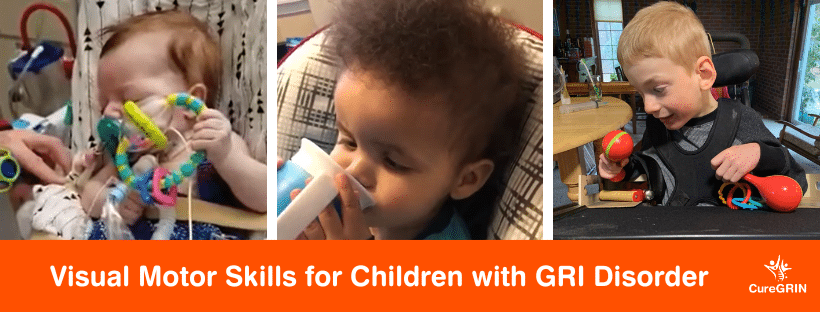Visual Motor Skills for Children with GRI Disorder
Share This Post

Stages of Hand Eye Coordination and Ways to Promote at Home
Developmental delays including gross motor, fine motor, vision, and speech are common with GRI Disorder. Children diagnosed with GRI Disorder often continue to miss milestones and many never accomplish even the simplest of skills. Their weeks are filled with therapy appointments to help them learn skills and families try to replicate these activities at home to reinforce them. Helping individuals with GRI Disorder retain skills is even harder during quarantine and telehealth times. Many families worry their kids will regress in their skills. This article focuses on visual motor skills (hand eye coordination) and offers home activities to help those with GRI Disorder improve these abilities.
Visual motor skills are important for individuals to develop so that they can fully participate in their daily lives. A child needs hand eye coordination for activities such as reaching for desired toys, bringing a cup to their mouth and participating in self-dressing. These tasks are especially difficult for those with developmental delays, including many GRI Disorder individuals.
Visual motor development happens in stages but can be especially challenging for those with Cortical Visual Impairment (CVI) that often accompanies GRI Disorder. CVI can slow these stages significantly, but you will most likely notice when your child starts seeing their hands or objects. They begin to swat at toys positioned in front of them or act surprised when objects appear in front of their face. The first step in visual motor development is the ability of a baby to track items with their eyes. After visually locating items, babies will explore with their hands by reaching for items in their visual fields. Babies continue to reach towards objects and will miss-judge their reach, either reach too far, too short or to the side of the object. The continued practice of reaching and missing then reaching again helps develop the coordination between visual skills and muscle activation.
When a child has decreased visual skills, muscular strength or endurance developing hand eye coordination can be a bit more challenging. Below are ways to promote visual motor skills in your child who may be experiencing limited vision or motor skills and some things to consider.
Positioning:
Children need strength in their postural (core) muscles and arms to be able to reach towards objects. Because hypotonia (low muscle tone) is common with GRI Disorder, specific support is often required as well. Ways to support appropriate alignment and building strength include:
Place your child in a supportive seat and encourage him to reach towards an object. Try guiding him at his elbow or wrist.
Place your child on his back or tummy and introduce visual stimuli to promote activation of different muscles.
If seated, support your child’s arms on a table or tray and position visually stimulated objects in front of them
Progress to cross midline reaching after your child has accomplished forward reaching. Encouraging your child to reach across midline in both directions helps develop central nervous system communication between your child’s brain and limbs.
When reaching, a child with hypotonia will benefit from added support. For example, when reaching across midline, place your full hand on your child’s shoulder of the arm he or she is reaching with to support the joint and prevent hyperextension or displacement.
Postural muscles are activated by certain visual stimuli. Imagine you are relaxing in a chair then all of the sudden, BAM! A bright shiny object goes flying through your visual field. You instantly sit up straight and become more alert. You can use bright, high contrast, moving objects or toys of interest as a way to promote postural activation with your child during play activities. Depending on your child’s visual skills, make sure you are giving them stimuli they can see!
Visual Considerations:
Providing vision-friendly materials and environment is crucial for visual development.
Provide 5-10 minute visual warm-up period before asking your child to make choices. Those with CVI often look away from toys and objects or close their eyes. Allow him or her these visual breaks.
Decrease visual and auditory clutter when asking your child to do a visual task or listen to auditory directions or teaching activities.
Limit background distractions such as windows and busy prints. Sit your child facing away from windows.
Use high contrast materials against solid surfaces or background. Using bright, shiny, high contrast and simple visual materials is very important.
Use a flashlight to improve child’s visual attention. Spotlight the item you want your child to attend to or move it forward. Movement of the object makes visual tasks easier.
Use touch, vision, and auditory input together for your child to improve his or her attention to toys and objects.
Infants are often attracted to the colors red and yellow at first.
If using lighted toys, try to create contrast by dimming lights. Be careful of fast-flashing lighted toys as they sometimes trigger seizure activity in those prone to seizures.
Limit choices to 2 or 3 and limit extraneous sensory input
The development of hand eye coordination is crucial in the overall development of your child. If you have concerns regarding your child, you can request an evaluation with an occupational therapist who is trained in promoting visual motor skills.
Danielle Doria Braman, MSOT,OTR/L, C/NDT
Owner of Purple Turtle Pediatric Therapy
Occupational Therapist
Read more Posts
2023 GRI Conference
GRI Conference brings together GRI families, researchers and clinicians, and industry representatives from around the world to educate, collaborate and network for treatments and cures for GRI Disorders.

CureGRIN’s Letter to the CDC Regarding ICD-10 Codes for GRI Disorders
Since our founding in 2019, CureGRIN has been working tirelessly alongside researchers, clinicians and industry to accelerate the path to treatments and cures. There are many promising compounds and genetic treatments, but there are barriers in getting those to clinical trial. Adding ICD-10 codes for these nine genes would remove a significant barrier to clinical trials, by helping us to better understand where our patients are located.
